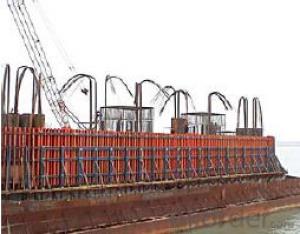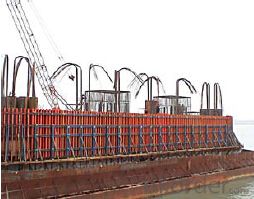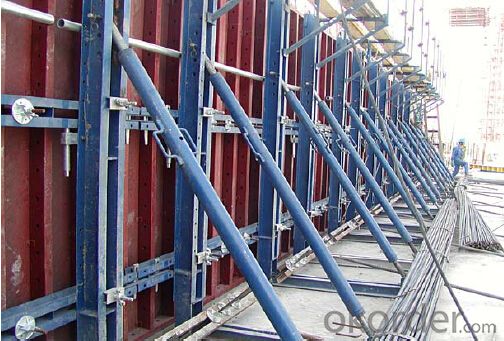Single Side Climbing Bracket SCB180 for formwork and scaffolding system
- Loading Port:
- Tianjin
- Payment Terms:
- TT OR LC
- Min Order Qty:
- 50 m²
- Supply Capability:
- 1000 m²/month
OKorder Service Pledge
OKorder Financial Service
You Might Also Like
Single-side Climbing Bracket SCB180:
With CNBM SCB 180 climbing systems, the loads from the fresh concrete pressure are transferred through the brackets by means of V-strongbacks and compression braces into the scaffold anchors.
Typical applications for the SCB 180 are dams, locks, cooling towers, pier heads, tunnels, and bank vaults.
The formwork is simply tilted backwards when striking takes place. The 1.80 m wide bracket requires only a minimum of space.
Characteristics:
◆ Economical and safe anchoring
The M30/D20 climbing cones have been designed especially for single-sided concreting using
SCB180 in dam construction, and to allow the transfer of high tensile and shear forces into the still
fresh, unreinforced concrete. Without wall-through tie-rods, finished concrete is perfect.
◆ Stable and cost-effective for high loads
generous bracket spacings allow large-area formwork units with optimal utilization of the bearing
capacity. This leads to extremely economical solutions.
◆ Simple and flexible planning
With SCB180 single-sided climbing formwork, circular structures can also be concreted without
undergoing any large planning process. Even use on inclined walls is feasible without any special
measures because additional concrete loads or lifting forces can be safely transferred into the
structure.
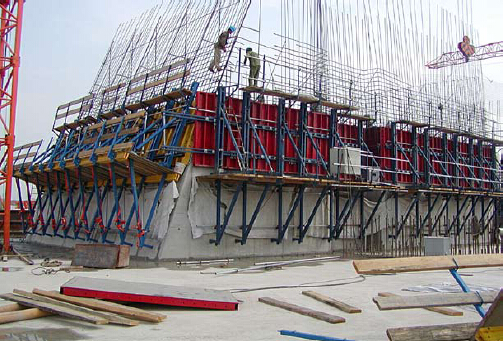
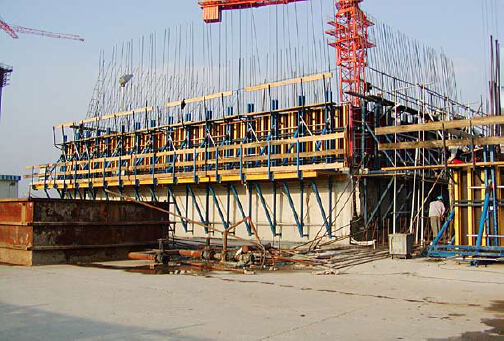
- Q: How does steel formwork affect the structural integrity of a building?
- Steel formwork is a construction technique that utilizes steel molds to create the desired shape and structure of concrete elements within a building. Its role in the construction process is pivotal and it impacts the structural integrity of a building in various aspects. To begin with, steel formwork acts as a robust and rigid support system for the wet concrete during pouring and setting. Its strength guarantees that the concrete retains its desired shape and prevents any deformation or collapse. This is particularly crucial for structural elements such as beams, columns, and walls, as it ensures their correct alignment and stability. Moreover, steel formwork allows for precise and accurate construction. The molds can be fabricated with exceptional precision, resulting in concrete elements with accurate dimensions and shapes. This precision is vital for maintaining the structural integrity of the building, as even the slightest deviation or misalignment can compromise its overall strength and stability. Furthermore, steel formwork produces a smooth surface finish for the concrete. This smoothness is not only aesthetically pleasing but also contributes to the structural integrity of the building. A smooth surface reduces the chances of cracks, voids, or air pockets in the concrete, which can weaken its strength and durability. In addition, steel formwork offers durability and reusability. Unlike other types of formwork such as wood or plastic, steel formwork can withstand multiple uses without compromising its structural integrity. This reusability not only saves construction costs but also ensures consistency in the quality of the concrete elements throughout the building. Lastly, steel formwork enhances the overall structural stability of the building. The use of steel molds creates a rigid framework that evenly and efficiently distributes the loads. This distribution minimizes the risk of localized stress concentrations, thereby improving the structural integrity of the building and increasing its resistance to external forces such as wind, earthquakes, or heavy loads. In conclusion, steel formwork has a significant positive impact on the structural integrity of a building. It provides a strong support system, ensures precision and accuracy, offers a smooth surface finish, provides durability and reusability, and enhances overall structural stability. All of these factors contribute to the strength, stability, and longevity of the building, making steel formwork an essential component in modern construction practices.
- Q: Can steel formwork be used for both standard and non-standard concrete shapes?
- Indeed, both standard and non-standard concrete shapes can be accommodated by steel formwork. The adaptability of steel as a material enables it to be effortlessly molded and manipulated to produce diverse formwork patterns. Furthermore, its robustness and enduring nature render it appropriate for intricate and intricate concrete shapes. Steel formwork can be tailor-made to satisfy precise project specifications, thus offering flexibility and customization in formwork design. Regardless of whether the desired shape is a conventional rectangle or an exceptional and unconventional design, steel formwork can proficiently be employed to shape and mold concrete structures of various dimensions and configurations.
- Q: How does steel formwork contribute to the overall cost of concrete construction?
- Steel formwork contributes to the overall cost of concrete construction in several ways. Firstly, the initial investment in steel formwork can be higher compared to other types of formwork materials such as timber or plastic. However, steel formwork offers long-term durability and reusability, which can offset the higher upfront cost over the lifespan of multiple construction projects. Additionally, the use of steel formwork can significantly reduce the time required for formwork assembly and dismantling. This leads to increased efficiency and productivity on the construction site, resulting in potential cost savings in terms of labor and project duration. Moreover, steel formwork is known for its superior strength and stability, which allows for the construction of larger and more complex structures. This can eliminate the need for additional support structures or reinforcements, ultimately reducing construction costs. Furthermore, steel formwork provides a smooth and high-quality finish to the concrete structure, eliminating the need for additional plastering or finishing work. This not only saves material costs but also reduces the overall construction time. Lastly, the reusability of steel formwork enables multiple applications on different projects, providing a long-term cost benefit. Unlike other formwork materials that may require frequent replacement, steel formwork can be used for multiple construction cycles, reducing the need for new formwork materials and saving costs in the long run. Overall, while the initial investment in steel formwork may be higher, its durability, efficiency, superior strength, and reusability contribute to cost savings in terms of labor, project duration, material usage, and long-term formwork expenses.
- Q: Is steel formwork resistant to corrosion?
- Yes, steel formwork is generally resistant to corrosion. Steel, particularly stainless steel, is known for its high resistance to corrosion, making it a suitable choice for construction applications. However, it is important to note that the extent of corrosion resistance can depend on factors such as the grade of steel used, the environment in which the formwork is used, and the presence of any additional protective coatings. Regular maintenance and proper care can also help prolong the lifespan and corrosion resistance of steel formwork.
- Q: What are the different types of connections used in steel formwork systems?
- The different types of connections used in steel formwork systems include bolted connections, welded connections, and clamped connections. Bolted connections involve using bolts and nuts to secure the formwork components together. Welded connections involve fusing the steel components together using welding techniques. Clamped connections use clamps to hold the formwork components in place. These different types of connections provide varying levels of strength, stability, and ease of assembly and disassembly in steel formwork systems.
- Q: Can steel formwork be used for precast concrete balconies?
- Yes, steel formwork can be used for precast concrete balconies. Steel formwork is commonly used in construction for various applications, including precast concrete elements. It offers several advantages such as durability, strength, and flexibility. Steel formwork can be easily fabricated to the required dimensions and shapes, allowing for the creation of complex balcony designs. It also provides a smooth finish to the concrete surface, reducing the need for additional finishing work. Furthermore, steel formwork can be reused multiple times, making it a cost-effective option for precast concrete balconies.
- Q: How does steel formwork contribute to the quality of the concrete finish?
- Steel formwork contributes to the quality of the concrete finish by providing a strong and rigid structure that ensures precise alignment and stability during the pouring and curing process. It helps to prevent any deformations, bulges, or surface irregularities, resulting in a smooth and even concrete surface. Additionally, steel formwork allows for greater flexibility in achieving intricate shapes and designs, enhancing the aesthetic appeal of the concrete finish.
- Q: How does steel formwork affect the overall timeline of a construction project?
- Steel formwork can have a significant impact on the overall timeline of a construction project. One of the major advantages of using steel formwork is its durability and reusability. Unlike traditional timber formwork, steel formwork can be used multiple times, which reduces the time spent on constructing and dismantling formwork for each concrete pour. The strength and rigidity of steel formwork also allow for faster construction cycles. Since steel formwork can withstand higher concrete pressure, it enables faster pouring and setting of concrete, leading to shorter curing times. This, in turn, allows subsequent construction activities to commence earlier, ultimately accelerating the overall project timeline. Moreover, steel formwork is known for its precision and dimensional stability. It provides a smooth and accurate surface finish, eliminating the need for additional plastering or leveling work. This saves time and reduces the number of construction activities required, further enhancing the project timeline. Additionally, steel formwork is typically prefabricated, meaning it is manufactured off-site and delivered to the construction site ready for assembly. This significantly reduces on-site construction time, as the formwork can be quickly erected and adjusted to the desired shape and dimensions. This timely installation ensures that other trades can progress with their work without delays, ultimately speeding up the overall construction process. However, it is important to note that the initial setup time for steel formwork can be longer compared to other types of formwork, as it requires careful planning and coordination. The formwork design must be accurately calculated, and any modifications or adjustments may take additional time. Nevertheless, the time saved during subsequent concrete pours and other construction activities usually compensates for this initial setup period. In conclusion, steel formwork positively impacts the overall timeline of a construction project by reducing the time spent on constructing and dismantling formwork, enabling faster concrete pouring and curing, providing a precise and finished surface, and facilitating quick and efficient on-site assembly. Its durability and reusability contribute to a more efficient and timely construction process, resulting in a shorter overall project duration.
- Q: Can steel formwork be used in areas with high humidity?
- Yes, steel formwork can be used in areas with high humidity. Steel is a durable and corrosion-resistant material that can withstand moisture and humidity without significant degradation. However, regular maintenance and protective coatings should be applied to ensure the longevity and performance of the steel formwork in such conditions.
- Q: Can steel formwork be used for staircase construction?
- Indeed, steel formwork is perfectly suitable for the construction of staircases. This versatile and resilient material is frequently employed in construction ventures, including staircase construction. It furnishes a robust and secure framework for pouring concrete and guarantees the meticulous and precise formation of the staircase. Moreover, steel formwork can be reused, rendering it a cost-effective option for repetitive construction procedures such as staircase construction. Furthermore, it offers adaptability in terms of design, enabling the creation of diverse staircase shapes and dimensions. In summary, steel formwork is an ideal selection for staircase construction due to its potency, durability, reusability, and design flexibility.
Send your message to us
Single Side Climbing Bracket SCB180 for formwork and scaffolding system
- Loading Port:
- Tianjin
- Payment Terms:
- TT OR LC
- Min Order Qty:
- 50 m²
- Supply Capability:
- 1000 m²/month
OKorder Service Pledge
OKorder Financial Service
Similar products
Hot products
Hot Searches
